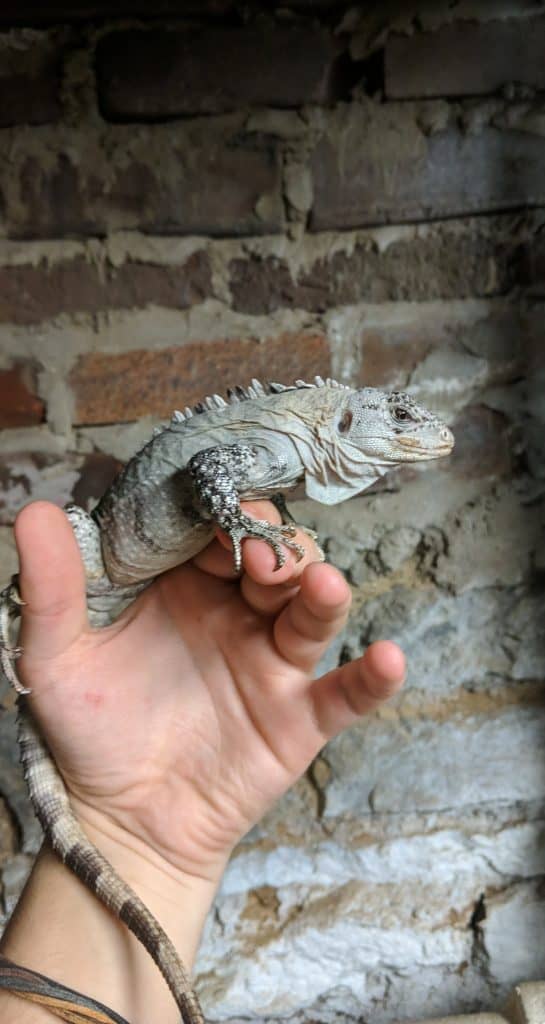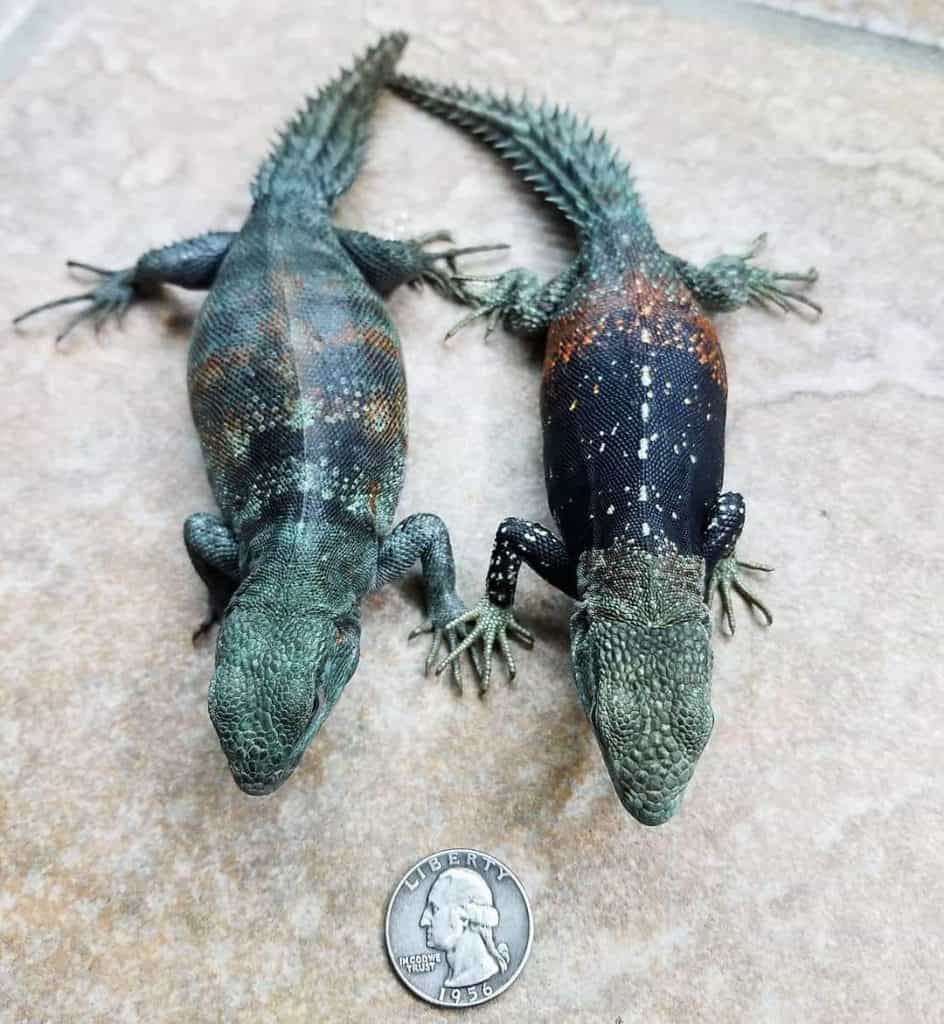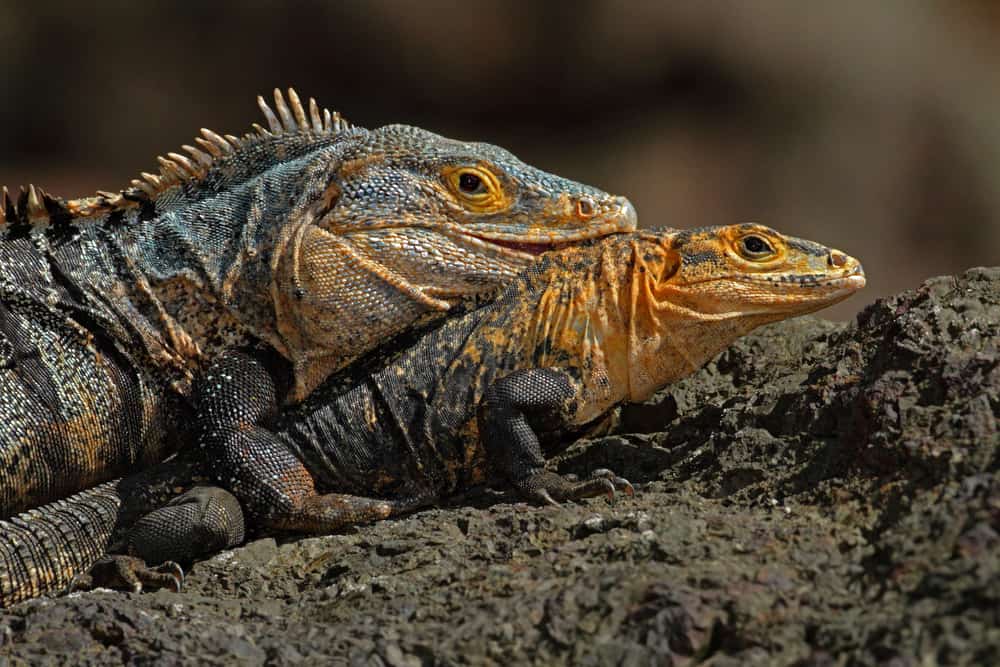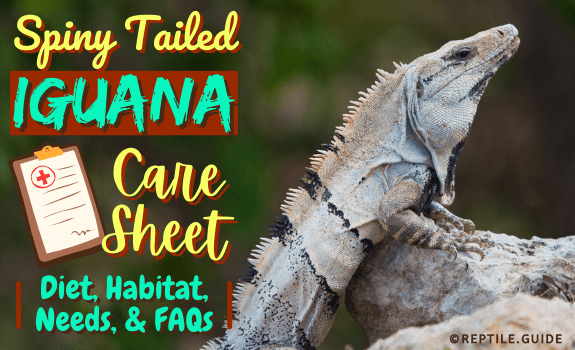Spiny tailed iguanas are medium-sized animals in the genus Ctenosaura.
The black spiny-tailed iguana and Mexican spiny-tailed iguana are two common species in the pet trade. If you buy a baby spiny-tailed iguana, it’s probably one of these two types.

Image credit: u/xXArcKnightXx (via Reddit.com)
The spiny-tailed iguana diet consists of foliage and vegetables with some fruit and feeder insects.
Keeping a spiny-tailed iguana as a pet is rewarding if you socialize it well and meet its needs. Let’s delve further into spiny-tailed iguana care.
In This Article
Spiny-Tailed Iguana Basics
Spiny-tailed iguanas get their name from the series of scaly spines which cover the animal’s backbone, including its tail.
The most common spiny-tail in the pet trade is Ctenosaura similis. Others that pop up from time to time include:
- Ctenosaura pectinata goes by Mexican spiny-tail.
- Ctenosaura melanosterna has striking black and white coloration.
- Ctenosaura bakeri is endangered in the wild. More and more are popping up in captivity thanks to captive breeding.
- Ctenosaura alfredschmidti is one of the most colorful varieties. They change colors multiple times as they grow.

Image credit: u/indicator_species (via Reddit.com)
The spiny-tailed iguana, Ctenosaura sp., as a group has a distribution covering a large part of the Americas.
The range extends from Southern Brazil, through Central America, and into the South-West of the USA.
Taxonomists recognize 15 different species in the genus, though not all of them are in the pet industry.
Their conservation statuses differ. Species like C. similis and C. pectinata rate as “least concern” (no current risk of extinction) while C. bakeri is “critically endangered”.
At least one species, C. pectinata, has become invasive in Texas and Florida. And Florida also has to contend with renegade C. similis.
Are Spiny-Tailed Iguanas Good Pets?
Spiny-tails make excellent pets.
Unlike the larger Green Iguana (Iguana iguana), spiny-tailed iguanas are friendly and docile.
If socialized from a young age, and well cared for, spiny-tailed iguanas make excellent pets.
If you get an adult iguana that wasn’t handled much as a youngster, it may be impossible to tame it. Some are tamable, but it takes a lot of time.
If you want a worthwhile pet that you can handle it’s best to buy young spiny-tails and raise them.
Spiny Tailed Iguana Substrate
Spiny-tailed iguanas do well on a substrate that can maintain some moisture.
They don’t have the high humidity requirements of some reptiles, but they appreciate a humidity of around 70%.
Some of the best substrates for these lizards include:
- Cypress mulch
- Coco coir
- Orchid bark
All these substrates are easy to spot clean, hold sufficient moisture (if misted daily), and are cheap to replace.
Spiny-Tailed Iguana Heating and Lighting
The most common spiny-tails in the pet trade come from South and Central America. These iguanas live in deserts and hot, rocky environments.
To thrive in captivity, they need a temperature gradient that reflects their native habitat.
As with other reptiles, the spiny-tails don’t produce body heat. They adjust their body temperatures by moving between warm and cool areas.
Any enclosure for spiny-tails should incorporate a hot basking area and a cool area. Ensure that the ambient (overall) temperature of the enclosure stays within a healthy range.
We suggest including three high-quality thermometers in the enclosure:
- One under the hot spot
- One in the cool area
- One somewhere in between to monitor the ambient temperatures
This thermometer setup allows you to monitor all the relevant temperatures in the enclosure.
These are the ideal temperatures for spiny-tailed iguanas:
- Hot spot: Around 106 °F
- Cool zone: 75-85 °F
- Ambient daytime temperature: 75-85 °F
- Ambient nighttime temperature: 70-75 °F
Spiny-tails are true basking lizards. The best approach is to give them a basking lamp to achieve the desired temperatures.
Ensure that you place some kind of mesh screen or light guard around the bulb, so the iguanas can’t burn on the lamp.
The spiny-tailed iguanas are active during the day. They need an intense lighting system to keep them healthy.
To give your iguanas the best life, ensure that you combine the basking lamp with full-spectrum lighting. They need UVB lighting to process calcium and other trace minerals.
Place the full-spectrum light no more than ten inches from the basking site, so they can absorb optimal amounts of UV.
If you’re using traditional bulbs (not LED), it’s essential to replace the full-spectrum bulb every six months. The amount of UV produced decreases after this time.
We recommend a high-quality full-spectrum LED setup since they last longer.
Spiny-Tailed Iguana Diet
Spiny-tailed iguanas are herbivores for the most part.
In the wild, these lizards thrive on eating the foliage of different native plants. They’re typical opportunists though.
They’ll eat any small animals, eggs, or easy protein that they come across.
The nice thing about these reptiles is, whether you have a black spiny-tailed iguana, C. similis, or a western spiny-tail iguana, C. pectinata, the diet is similar.
Try to offer as diverse a diet as possible, focusing on greens, vegetables, and some fruit. Feed fruit twice a week, rather than every day, since they have high sugar content.
Young lizards require insects (no larger than the iguana’s head) every other day. Adults should only get feeder insects as an occasional treat.
Of course, you can buy prepared iguana pellets, but you should supplement them with as many fresh foods as possible.
If you’re curious, you can also check out what other iguanas eat to learn more about feeding your new friend a balanced diet.
How Big Do Spiny-Tailed Iguanas Get?
How big do spiny-tailed iguanas get? Between 30 inches and around five feet, depending on the species.

When you buy a spiny-tailed iguana it’s essential to find out which species you’re getting.
There’s a vast size difference among the different types, and adult males get larger than females. Here are a few examples:
- Ctenosaura similis – Adult males can reach lengths of up to three feet and three inches
- Ctenosaura pectinata – Can reach lengths of around four feet
- Ctenosaura bakeri – Maxes out at 30 inches
Spiny-Tailed Iguana Enclosure Size
As you can tell, there’s a fair amount of variation in the sizes of these reptiles. It’s a good idea to build or buy an enclosure based on the size of the males of the spiny-tail you have.
For larger animals, like C. similis and C. pectinata, you need an enclosure of at least eight feet long, four feet wide, and six feet high.
Smaller species, like C. bakeri, can live in an enclosure that’s three feet long, one-and-a-half feet wide, and three feet high.
Try to provide a larger enclosure if possible because these are active lizards.
Enclosure Setup
While these animals aren’t arboreal, they love to climb. The best setup for them involves branches, rocks, and other things they can climb on.
Ensure that the top of the climbing areas is in the range of the basking lamps.
Hides are an essential part of the enclosure setup, and you can place them on the ground or in-between the branches.
In the wild, these creatures nest in any available space. They may even share an animal burrow with tortoises and other creatures.
When cohabiting with humans, these animals move into house rafters or cellars.
They’re not picky about hide types, but distribute the hides throughout the temperature gradient.
Ensure that the enclosure features a large water bowl they can drink from and wade in.
If you live in a place with an average temperature of over 75 °F, you can give these animals an outdoor enclosure.
These animals love to bask in the warm sunlight, and you’ll save on heating and lighting.
Ensure that you also have an indoor enclosure for if the weather drops, or a weather-proof outdoor heating system.
Outdoor enclosures typically consist of metal or wood framing with a hardware cloth cover. Ensure that it has a concrete or stone base so the lizards can’t burrow their way out.
The rest of the setup is basically the same as for an indoor enclosure.
Mexican Spiny-Tailed Iguana vs Black Spiny-Tailed Iguana
The most common spiny-tails in the pet trade are the Mexican and Black spiny-tailed iguanas.
When you have the option to choose between the two, it’s a matter of taste.
Mexican spiny-tails are large, reaching over four feet. They’re brown or olive green with black bands across their backs and a long tail.
Black spiny-tailed iguanas are black, as their name suggests, but can also be brown or gray. They grow to five feet, have bands across their backs, and sport a long tail.
Males of both species have small dewlaps.
In temperament, diet, and habitat requirements, the two animals are similar.
Are Spiny-Tailed Iguanas Dangerous?
These animals aren’t dangerous at all. In the wild, they rely on high speeds to escape predators.
An angry iguana may deliver a nasty blow with its tail (which is covered in spines) and can bite.
They prefer threat displays to biting, and bites aren’t serious when they occur (but can be painful). If your iguana seems grumpy, it’s best to leave it alone.
We hope you’ve enjoyed this article about spiny-tailed iguanas.
If you’re not sure that this is the right pet for you, you might find our iguana vs bearded dragon article useful.
We also have plenty of other care sheets for different types of lizards, including some of the largest pet lizards, and best pet lizards.
More experienced keepers may find the rhino iguana an interesting and rewarding challenge.
If your interest is more general, you might also enjoy the article about California lizards.
Would you like a pet spiny tail? Let us know in the comments.
